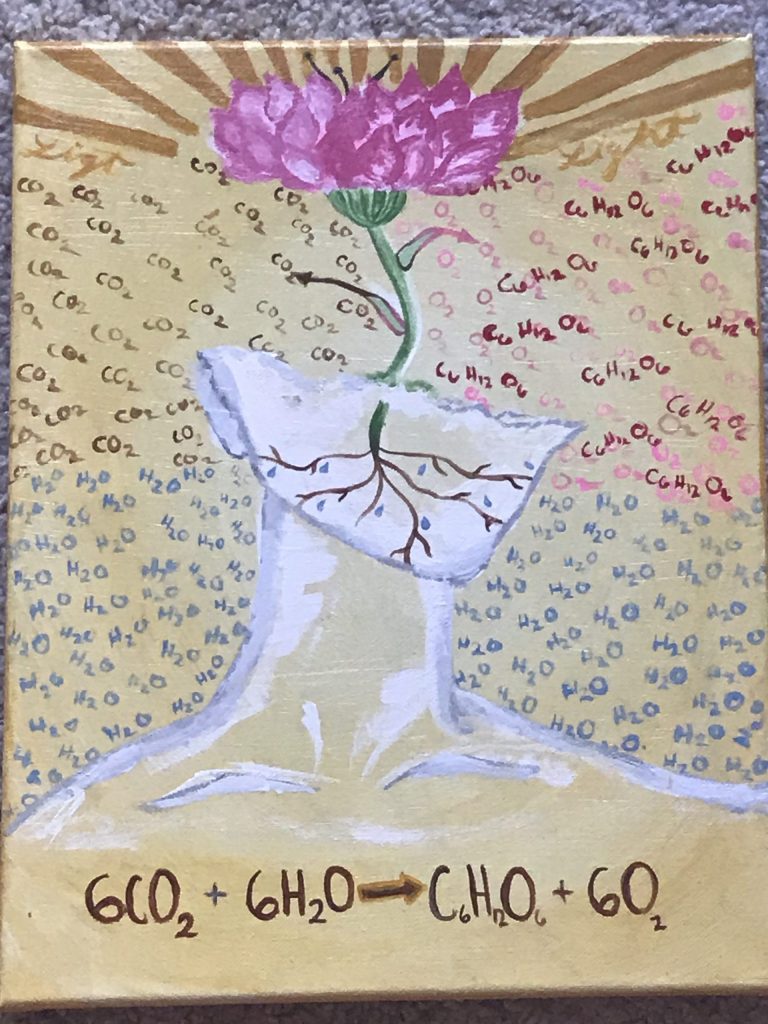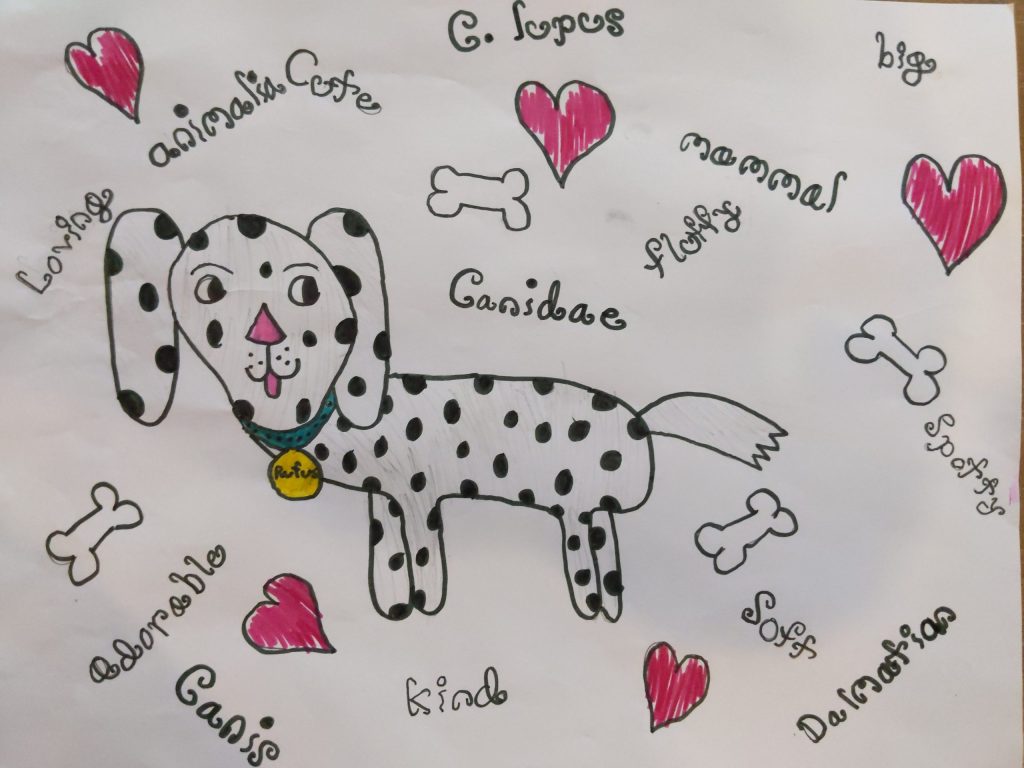LSOP Art of Science Contest — Spring 2021
This contest ran through April, 2021 and was open to all students enrolled in grades K-12 in a public or private school in the United States. Students were asked to submit an original science-inspired artistic composition in any field of science using any artistic medium. Entrants connected with Colorado State University students and staff to help them develop ideas for their entries. Every entry was evaluated by our team of CSU students and staff, and every entrant will receive detailed feedback on their submissions. Winners will receive certificates and awesome prizes!
For the latest on the Art of Science contest, please click here. Thank you to all who entered and congratulations to the winners!
Best in Show
Photosynthesis
by Lina Meddah, 10th grade, The Vanguard School
My name is Lina Meddah and my project is named Photosynthesis. I painted a unique perspective on the process of photosynthesis. I painted a neck, shoulders, and a flower blossoming from the neck. The purpose for this is to put emphasis towards the plant and remind everyone that it is also alive. I also painted the parts of Photosynthesis around the plant. This shows the process that the flower goes through during photosynthesis, specifically how carbon dioxide and water cause the plants to synthesize their food.
Sources:
- The reference i used for my painting of the process of photosynthesis was my Holt Chemistry textbook. The picture and description about photosynthesis I used for my project can be found on page 734.
Best Entry by an Elementary Student
The Amazing Dalmatian Creation
by Pepper Lynch, 2nd grade, Prospect Ridge Academy
This is my zoology picture that describes the Amazing Creation that the Dalmatian is. One of my very favorite kinds of dogs!
Best Visual Art Composition
The Splendor of Autumn
by Chloe Beaudreau, 11th grade, Carnegie Vanguard High School
Every fall we relish the brilliant colors that seep into our forests and natural landscapes—the beautiful hues of orange, red, and yellow that remind us of pumpkins and Thanksgiving. It’s as if the Earth is preparing nature for the upcoming festivities, but what process really occurs to change the color of leaves as the seasons transition? Because of changes in temperature and the length of daylight, leaves stop their food-making process. This means that chlorophyll, the special chemical that absorbs energy from sunlight for the process of photosynthesis, breaks down. Since chlorophyll is also a green pigment, the green of the leaves is reduced and the other pigments—carotenoids, xanthophylls, and anthocyanins become visible. I created this painting out of oil paints to highlight not only the beauty of Fall, but the magical colors it consists of. I was inspired to make this when I learned about chlorophyll and pigments in biology class.
References:
Best Representation of a Scientific Concept, Experiment, or Achievement
Why Doesn’t Sink Water Flow Evenly?
by Sarah Smith, 11th grade, The Vanguard School
Have you ever wondered why the water does not come straight down from the sink, but gradually gets narrower as it gets closer to the basin of the sink? The answer lies, as the video explains, in the principles of conservation of energy and continuity. When we apply the principle conservation of energy to the water flow, we discover that the velocity of the water stream is greater at the bottom than at the top. Once we know that, we can use the continuity equation to demonstrate how the stream of water is narrower at the bottom than at the top. However, is does deserve mention that some sinks have faucets with special lips that negate this. Nevertheless, for most sinks, the demonstration holds true, and is a great opportunity to learn a little bit more about science!
References:
- Britannica, The Editors of Encyclopaedia. “Potential energy”. Encyclopedia Britannica, 26 May. 2020, https://www.britannica.com/science/potential-energy. Accessed 6 April 2021.
- Britannica, The Editors of Encyclopaedia. “Conservation of energy”. Encyclopedia Britannica, 27 May. 2020, https://www.britannica.com/science/conservation-of-energy. Accessed 6 April 2021.
- Britannica, The Editors of Encyclopaedia. “Continuity principle”. Encyclopedia Britannica, 20 Feb. 2009, https://www.britannica.com/science/continuity-principle. Accessed 6 April 2021.
Best Use of Humor to Explain a Scientific Concept
This plant looks mighty happy if I do say so myself!
by Ryan Wilson, 9th grade, The Vanguard School
This stop motion represents photosynthesis, the process that makes food and other necessary products for photosynthetic organisms. Nothing really happens in the stop motion because you can’t see the process from the outside. Use your imagination!
References:
- West-Eberhard, Mary Jane, et al. “Photosynthesis, Reorganized.” Science, vol. 332, no. 6027, 2011. JSTOR, www.jstor.org/stable/29784070. Accessed 8 Apr. 2021.
Honorable Mention
Instrumental Piano
by Aspen Gatteau, 8th grade, Lesher Middle School
I researched the piano. A piano has both transverse (strings) and longitudinal (the actual sound coming out). Bartolomeo Cristofori invented the piano in 1709. It is used to play many styles of music. It sharpens fine motor skills and makes your muscles stronger. When someone presses the key down, a felt-covered hammer hits the string. If you press it down softly, the hammer will hit softly, creating a quiet sound. If you press the key down hard, the hammer will hit the string hard, creating a louder sound. One fun fact about pianos is that the first pianos were too expensive for even the very wealthy to own. Another fun fact is that the word piano is the shortened version of the word pianoforte, which means soft (piano) and loud (forte). Another fun fact is that pianos have a total of 88 black and white keys.
References
- https://scholarship.rollins.edu/cgi/viewcontent.cgi?referer=&httpsredir=1&article=1033&context=stud_fac#:~:text=of%20transverse%20standing%20waves%20in,transverse%20waves%20that%20produce%20them
- https://www.pianoemporium.com/10-benefits-playing-piano/#:~:text=It%20sharpens%20fine%20motor%20skills,stronger%20than%20the%20average%20person
- https://www.ducksters.com/musicforkids/piano.php#:~:text=The%20piano%20is%20one%20of,pop%20to%20classical%20to%20jazz
- https://www.yamaha.com/en/musical_instrument_guide/piano/structure/#:~:text=The%20piano%20was%20invented%20by,in%20around%20the%20year%201700
- https://www.abc.net.au/classic/read-and-watch/how-music-works/how-does-a-piano-work/11192076#:~:text=In%20a%20piano%20the%20string,resulting%20in%20a%20loud%20sound
- https://www.metmuseum.org/toah/hd/cris/hd_cris.htm
- https://www.pianoemporium.com/piano-trivia-and-fun-facts/
Honorable Mention
The Life of a Tree
by Genecarlo Soto, 11th grade, The Vanguard School
When it comes to science, “The Life of a Tree” is a visual representation of a chemical reaction (Chemistry) tying in with the carbon cycle (Biology) in nature. It begins with a tree log sitting on the ground, but the sun comes out and emits enough heat to spark a chemical reaction. The burning log is not just any chemical reaction, but one characterized by combustion. Combustion always includes an organic molecular compound and oxygen as reactants; Combustion reactions always include carbon dioxide and hydrogen dioxide. To continue, after the sun blazes, the tree absorbs enough energy, in the form of heat, to start smoking, but the fire does not start until the wind passes by. In the process of the wind passing by, it provides more oxygen to the reaction; this is enough to begin the chemical breakdown. As the fire burns the log, its molecular compounds break down, and it eventually turns to ash which completely changes the substance’s identity. When the fire dies, the wind blows again and spreads the ash to the earth. The ash and remains of the log mesh back into the ground. Decomposition reintroduces the atoms (including carbon) into the sediment. As a result, the carbon cycle paves the way for new life to take form. A tree grows from the ashes using the sun’s rays for photosynthesis.
The visual representations in this stop motion are pretty simple. The glasses case, placed in the center of the video, represents the old tree log and the yellow bottle on the top right represents the sun. Then the sun’s rays/energy is shown with the movement of the white rectangular and orange swirly notecards. The tissue is the wind/influence of oxygen; The triangular orange notecards are the fire/flame; The belt is the tree’s ashes; The green notecard is the new sapling; The green rectangular notecards is photosynthesis.
References:
- Riebeek, Holli. “The Carbon Cycle.” NASA Earth Observatory, NASA, 16 June 2011, earthobservatory.nasa.gov/features/CarbonCycle.
- Bassham, James Alan. “Photosynthesis.” Britannica, Britannica, 12 Feb. 2021, www.britannica.com/science/photosynthesis.
- “Burning of Wood.” VTT Research, VTT Technical Research Centre of Finland, http://virtual.vtt.fi/virtual/innofirewood/stateofthttp://www.britannica.com/science/photosynthesis.heart/database/burning/burning.html#:~:text=Under%20the%20influence%20of%20heat,wood%20to%20ignite%20and%20burn.&text=Gaseous%20substances%20react%20with%20each,induces%20pyrolysis%20and%20combusti






